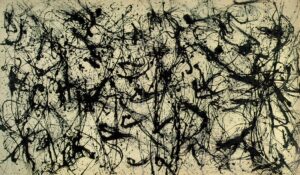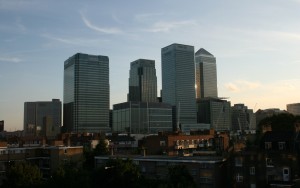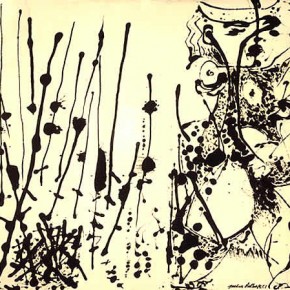
Criss-crossing unfamiliar avenues in an attempt to defamiliarise my connection with my home turf; I took the long meandering way…
Like a thread unravelling before me in the streets, walking in Poplar provides a visual provocation between wealth and poverty, sleek skyscraper technology and raw unmaintained concrete, American pastiche and British Modernism. This reminds me of the film Sugarhouse (2007). Directed by Gary Love and starring Andy Serkis, it tells a story of a chance encounter between a crack addict from Robin Hood Gardens and a businessman from the City. The stark urban juxtaposition is used as a tapestry, symbolising the collision of the characters’ separate worlds.
Photo of Canary Wharf taken from Robin Hood Gardens
My feet carrying me ever forward, I’m passing through a condensed realm; a cinematic concentration of global montage. Along East India Dock Road away from Balfron Tower (my home), shop fronts and restaurants contract disparate geographies and cultures on one street… Walking through a time corridor, I was barely touching the ancient traces of a landscape once military and industrial; the corporate towers overhead dominate, dwarfing the vestiges of the docklands as it once was.
Sauntering slowly, devoid of purpose, was my best mode of travel. Heading southbound from Balfron, I was caught up in the embrace of an urban Number 7.
Jackson Pollock’s lovers, although sedentary, are an evocation of movement; I imagined the artist’s frame hovering energetically above the canvas, dripping paint in Hansel and Gretel style, marking the tracks of his trajectory. Channelling Guy Debord(1) on this walk of free association to reinvigorate my passion for the city, I looked up at this ‘Mini Manhattan’, my sight resting on Canary Wharf Tower; its brethren superstructures on all sides.
A powerful symbol of the regeneration of the Docklands, Canary Wharf’s carefully composed spaces marks a clear boundary between it and the surrounding urban sprawl, including the impoverished estates to the north – a flagrant urban contrast. With the lucrative centre of commerce standing lustrous and tall above the degradation, I feel a strong sense of the ‘right’ and ‘wrong’ side of the tracks.

Amplifying the role of process over product – modes of action above a representation of the object, Pollock’s journey is not about arrival but the dance; a performance that is objectified in his crystallised gestures on canvas. Walking along Canary Wharf’s North Colonnade, the left-side of Pollock’s Number 7 springs to mind; straight, directional and punctured by concentration points, these threads of ink are a journey in conceptual space, a translation of my route and the rhythm of my path.
I think about artist and writer David Wojnarowicz, writing about walking like a refrain, a beat tapping itself out with his words. Unlike me, he refused to pause; for him, movement was continuous, his prose never tempted by the lure of the full stop(2). I dwell in these abstract pauses, slowing down to contemplate, resting and reflecting temporarily before departing once more, following the thread beneath my feet.
As I walked up and over Poplar station’s bridge above the rail tracks that connect to the city’s centre, the towers got bigger, and so did their signatures; HSBC, CitiBank, Credit Suisse, Barclays; corporate branding conspicuously emblazoned on their facades. Ambling ever closer, soon I would be too near the tallest structure, Cesar Pelli’s One Canada Square, to see its pyramid top.
Past the lunch hour, there is a stark lack of people. I imagined phantom walkers with BlackBerries to hand, their movements brisk and purposive, turning the wheel of fortune and finance in a never-ending dance. Imagining a scramble of lines; strings of past movement stretched out along the pavement, I painted the landscape in my mind’s eye, in Pollock style, picturing something like this canvas.

Like solidified smoke in space, an encapsulation of bodies in flux, layer upon layer of routes have traversed this space. Patterns of sinuous and linear curves meandering on the concrete before me unfold in a kinaesthetic place-ballet; like Pollock’s own scores, these marks are the traces of a time-space-routine that is continually repeated, where ghosts move back and forth, numerous and silent, in private streets dressed up as public property. I looked up, for this is the only way to tell which bank headquarters belong to which glass façade. The Royal Observatory beyond the River sprang to mind, another architectural construct urging a craning of the neck to look up at the sky.
 Greenwich Maritime Museum & Canary Wharf
Greenwich Maritime Museum & Canary Wharf
(1) Debord, a pioneering figure of the Situationist International (a group of avant-gardes that promoted strategies for urban walking) promulgated the idea that passion could be exhumed from cities through increased pedestrian mobility, bringing together a community of angelic lovers.
(2) Solnit, Rebecca The Art of Walking (2001).



Leave a Reply